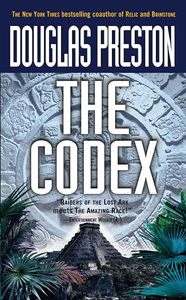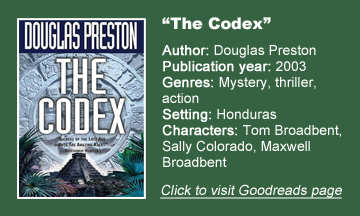Before Douglas Preston set foot in the fabled White City of Honduras, as chronicled in 2017’s “Lost City of the Monkey God,” he imagined going there in “The Codex” (2003). While it’s mildly disappointing, given the title, that the book doesn’t chronicle a code-breaking mystery, it is an adventurous trek through the jungles, rivers and mountains of Honduras.
You’ll be happy to visit it in book form rather than going there yourself, as Preston paints an evocative picture of the land – and its corrupt politicians and differently cultured natives – serving up one death-trap after another.
Enter the Broadbents
The jungle trekkers are the Broadbent brothers – Utah horse doctor Tom, later of “Tyrannosaur Canyon”; spiritual seeker Vernon; and wealth-enjoyer Philip, who most takes after their dad, Maxwell. The cancer-ridden elder Broadbent has buried himself in a tomb in the White City with all of his riches; the sons must reach the city to claim their inheritance.
Among those riches is the titular Codex, which isn’t a code book but rather a Mayan medical encyclopedia.
In addition to the terrors of the jungle – including anacondas and jaguars and endless bugs – we get glimpses at the medicinal powers of the flora. It’s tantalizing to think about how good this book could be for everyone’s quality of life.
“The Codex” is one of those novels where I’m happy to encounter a chapter that takes a break from the harrowing adventure to check in with a suit in his office in the States. It’s a reprieve, but also a good thread in its own right. There are huge financial gains to be made by the pharmaceutical company that lands the Codex.
Preston nicely portrays one company’s top man, Lewis Skiba, and his delicious moral quandaries: To acquire the book, he must become a murderer. I love how his man in the field, Hauser, will only kill the Broadbents if Skiba orders him to, thus forcing Skiba to take moral responsibility.
Room for romance
The author goes into detail about the pharma company’s stock-market standing, providing a good flavor of how that world operates.
“The Codex” features a decent romance yarn between Tom and Sally Colorado, who will also return for “Tyrannosaur Canyon.” It’s rare in that it doesn’t follow the structure of a disenfranchised couple getting back together amid life-or-death stakes. Rather, they meet for the first time on this adventure.
Lots of chuckles are to be had as Sally rejects the playful womanizing of their guide, Don Alfonso Boswas, a colorful village chief who claims to be 121 years old. Sally often glares at poor Tom as if he’s on Don Alfonso’s side by dint of being the same gender.
Preston goes for one mystery thread that’s so thin I’m not sure it’s even supposed to be a mystery. But then he also gives us a great yet well-earned surprise via the character of Borabay, an Indian who calls everyone “brother” and longs to move to America.

Another kind of riches
As is Preston’s wont, “The Codex” is filled with gems and jewels and valuable books and paintings; he piles them high enough to create an evocative world of riches – monetary, yes, but more important to him (and his surrogate, Tom) is the history and the knowledge these items represent. That’s why the Codex is the most sought-after artifact by Tom and Sally.
While Preston paints quite a picture in this novel, his descriptions of the White City itself are a weak point. By the time we get there, “The Codex” has become a full-on action novel in the “Indiana Jones” vein. The area around the plateau-positioned city is striking, including a bridge over a misty chasm of unknown depth.
Local legend has it that it’s so deep that people die and turn to dust before hitting the bottom. Maybe it’s just my reading tastes, but when I get to the non-stop action of the final chapters (most of which are about two pages), I miss the build-up that preceded it.
Preston might’ve been holding back a bit on the White City, since it’s a fictional portrayal of a real (yet largely unexplored) place. It’s interesting that – thanks to the onset of new exploration technology — one author’s career covers his imaginings of a fabled place and his later visit to that same place.


